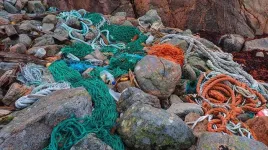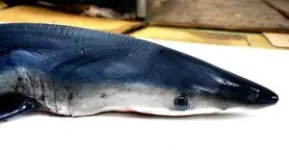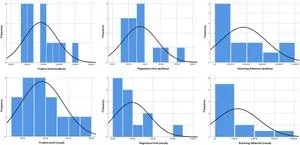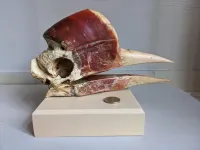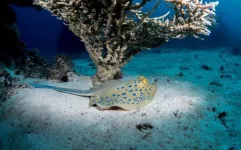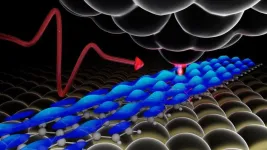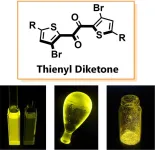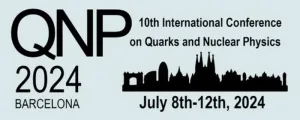(Press-News.org) Plastic items from around the world are continuously washing ashore on Norwegian coastlines. This reflects a much larger systemic issue facing the nations of the world.
Scientists have long reported the consequences of plastic pollution and the urgent need for intervention, but global plastic production and consumption continue to rise.
This underscores the importance of Norway’s advocacy for a global agreement that guarantees stopping the flow of plastics into the environment.
But Norway also has a responsibility in generating plastic pollution.
In a study conducted with the Norwegian Air Research Institute (NILU), researchers from the Norwegian University of Science and Technology attempted to map the Norwegian plastic cycle at high resolution– down to the product and polymer types.
Norway releases 15 000 tons of plastic to the environment each year
According to our recently published study in Environmental Science & Technology, around 758 kilotons (kt) of plastics enter the Norwegian market every year, while 632 kt is discarded as waste.
Almost the half of this waste is incinerated, and only 2.4% ends up in the environment.
Although 2.4% may seem insignificant, when translated into absolute masses, it equates to a substantial 15 kt, or 2.8 kg per capita.
On average, Norwegians consume 21% more plastics compared to Europeans and generate twice as much plastic pollution as the Swiss; this is equivalent to a staggering 1.5 billion plastic bottles that reach the environment each year.
Norway is pushing for a global agreement
Action against plastic pollution is finally gaining momentum as nations negotiate an internationally legally binding instrument for limiting plastic pollution.
By co-chairing the High Ambition Coalition to End Plastic Pollution together with Rwanda, Norway is setting the bar high.
But what can Norway do at home?
According to our study, there are two major pollution sources from the Norwegian economy:
Consumer packaging: The biggest source of macroplastics.
Tire wear rubber: Electric and hybrid vehicles have the worst performance.
Consumer packaging is the main “culprit”
Our study shows that the majority of macroplastics, items bigger than 5mm, mainly originate from consumer packaging, such as bottles and bags. Plastic packaging items are also among the most commonly found along Norwegian coastlines.
Efforts to limit the release of these products (e.g., decreasing littering and dumping, and increasing road sweeping) are completely overshadowed by high consumption rates.
We simply use more than what we can collect.
It is therefore essential to reduce plastic consumption in these categories to curb this pollution source.
Tire wear particles: a big source of microplastics
We have identified tires as a significant contributor to microplastic pollution, with approximately 6 kt of tire wear rubber released annually.
Capturing these particles is extremely challenging due to the nature of their emission.
Our study emphasizes rethinking mobility and transport choices as key to reducing this pollution source. Shared mobility options, such as public transport, are indeed part of the solution here.
Designing lighter vehicles and exploring alternative materials can also be effective to some extent.
Norway’s electric and hybrid vehicle fleet has rapidly expanded in recent years. While they produce lower carbon emissions, their heavier weight compared to conventional vehicles increases tire wear particle emissions.
Oceans choked by plastics
Why is plastic pollution so bad?
As a coastal nation, Norway’s land-based plastics can easily reach the ocean, given its high population concentration along fjords and long coastlines.
While the greatest percentage of plastic released to the environment ends up in the soil, nearly one-third ends up in the marine environment. It is important to note that a large part of what is deposited in soil will ultimately make its way to the ocean over time.
Marine plastic pollution has long been shown to cause irreversible impacts on ecosystems.
Animals often become entangled in or ingest plastic fragments. Fragments can act as a carrier of invasive species, and plastic debris has also shown the ability to interfere with the marine carbon cycle, further exacerbating climate change.
Plastic pollution is very toxic
To make matters worse, plastic products also contain a mixture of additive substances that are intentionally introduced during production to achieve specific properties.
Our study has demonstrated that high amounts of toxic additives, such as phthalate esters and organophosphate esters, are potentially released to the environment alongside plastics. Field studies (in Norwegian) have previously detected elevated levels of short-chain chlorinated paraffins in the livers of Norwegian herring gulls (Larus argentatus) after ingesting plastics. We estimated significant emissions of these substances from the Norwegian plastic economy.
The findings show that high additive amounts also enter recycling processes. This is problematic since plastic recycling can reintroduce these additives back to the economy.
In other words, recycled plastics can contain elevated levels of additives, which poses an additional risk to human health and the environment.
An urgent need for action
This research shows the importance of restraining plastic production and consumption and addressing the use of hazardous chemical additives.
Policies at home need to be imposed to limit the environmental consequences of the plastic economy.
This is urgent, and it has been urgent for a long time.
Reference: Marhoon, A., et al. Mapping Plastic and Plastic Additive Cycles in Coastal Countries: A Norwegian Case Study. Environ. Sci. Technol. 2024, 58, 19, 8336–8348 https://doi.org/10.1021/acs.est.3c09176
END
Norway can lead the fight against plastic pollution
Norway's long, rugged coastline – more than 28,953 kilometers long, including the fjords – suffers from plastic pollution even though it is so remote. It's a problem plaguing all nations of the world
2024-07-04
ELSE PRESS RELEASES FROM THIS DATE:
Decolonizing the Tropical Ecology curriculum
2024-07-04
A new study of curriculum reading material at the University of Glasgow finds that 94% of recommended Tropical Ecology authors are white, and that 80% of authors are affiliated with universities outside of the tropics. Dr Stewart White, Senior Lecturer at the School of Biodiversity, One Health and Veterinary Medicine at the University of Glasgow, UK, intends to change that.
“Tropical rainforest research was long the preserve of rich white men and the resulting literature was the same,” says Dr White. “This historical bias in tropical research and publication is still ...
Exploring the casque anatomy of aerial jousting helmeted hornbills
2024-07-04
New research reveals how the surprising internal anatomy of the helmeted hornbill’s casque allows it to withstand damage during aerial jousting battles with rivals. Researchers hope that this new understanding can help to conserve this critically endangered species, as well as provide new insights into developing impact-resistant bio-mimetic materials.
“When I started in Hong Kong, I visited City University of Hong Kong (HKU)’s conservation forensics group to chat about their research and they introduced me to this amazing bird, to its ...
A New Blue: Mysterious origin of the ribbontail ray’s electric blue spots revealed
2024-07-04
Researchers have discovered the unique nanostructures responsible for the electric blue spots of the bluespotted ribbontail ray (Taeniura lymma), with possible applications for developing chemical-free colouration. The team are also conducting ongoing research into the equally enigmatic blue colouration of the blue shark (Prionace glauca).
Skin colouration plays a key role in organismal communication, providing life-critical visual clues that can warn, attract or camouflage. Bluespotted ribbontail ...
Cool roofs are best at beating cities’ heat
2024-07-04
Painting roofs white or covering them with a reflective coating would be more effective at cooling cities like London than vegetation-covered “green roofs,” street-level vegetation or solar panels, finds a new study led by UCL researchers.
Conversely, extensive use of air conditioning would warm the outside environment by as much as 1 degree C in London’s dense city centre, the researchers found.
The research, published in Geophysical Research Letters, used a three-dimensional urban climate model of Greater London to test the thermal effects of different passive and active urban heat management systems, including painted “cool roofs,” rooftop solar panels, ...
Single atoms show their true color
2024-07-04
One of the challenges of cramming smarter and more powerful electronics into ever-shrinking devices is developing the tools and techniques to analyze the materials that make them up with increasingly intimate precision.
Physicists at Michigan State University have taken a long-awaited step on that front with an approach that combines high-resolution microscopy with ultrafast lasers.
The technique, described in the journal Nature Photonics, enables researchers to spot misfit atoms in semiconductors with unparalleled precision. Semiconductor physics labels these atoms as “defects,” which sounds negative, but they’re ...
Re-engineering cancerous tumors to self-destruct and kill drug-resistant cells
2024-07-04
UNIVERSITY PARK, Pa. — Treating cancer can sometimes feel like a game of Whac-A-Mole. The disease can become resistant to treatment, and clinicians never know when, where and what resistance might emerge, leaving them one step behind. But a team led by Penn State researchers has found a way to reprogram disease evolution and design tumors that are easier to treat.
They created a modular genetic circuit that turns cancer cells into a “Trojan horse,” causing them to self-destruct and kill nearby drug-resistant ...
Reversing chemotherapy resistance in pancreatic cancer
2024-07-04
Pancreatic cancer is a particularly aggressive and difficult-to-treat cancer, in part because it is often resistant to chemotherapy. Now, researchers at Stanford have revealed that this resistance is related to both the physical stiffness of the tissue around the cancerous cells and the chemical makeup of that tissue. Their work, published on July 4 in Nature Materials, shows that this resistance can be reversed and reveals potential targets for new pancreatic cancer treatments.
“We found that stiffer tissue can cause pancreatic cancer cells to become resistant to chemotherapy, while softer tissue made ...
New organic molecule shatters phosphorescence efficiency records and paves way for rare metal-free applications
2024-07-04
A research team led by Osaka University discovered that the new organic molecule thienyl diketone shows high-efficiency phosphorescence. It achieved phosphorescence that is more than ten times faster than traditional materials, allowing the team to elucidate this mechanism.
Osaka, Japan – Phosphorescence is a valuable optical function used in applications such as organic EL displays (OLEDs) and cancer diagnostics. Until now, achieving high-efficiency phosphorescence without using rare metals such as iridium and platinum has been a significant challenge. Phosphorescence, which occurs when a molecule transitions ...
International summit of experts in nuclear physics at the University of Barcelona
2024-07-04
More than two hundred international experts will take part in the 10th International Conference on Quarks and Nuclear Physics (QNP2024), a scientific summit organized by the UB Institute of Cosmos Sciences (ICCUB), which will be held in the Aula Magna of the Faculty of Biology at the University of Barcelona from 8 to 12 July. This meeting, hosted by the UB for the first time, will bring together world experts in the fields of nuclear physics and hadronic physics to discuss the latest advances in theory, experimentation and technology ...
Clever pupils don’t need to attend academically selective schools to thrive, study finds
2024-07-04
Findings published in a new peer-reviewed paper in the British Journal of Educational Studies challenges the idea that academically selective schools are necessary for clever pupils to achieve good outcomes.
Selective schools are government-funded schools that enrol only the highest performing students. Pupils take a standardized entrance exam, from which the best-scoring are enrolled.
Some argue that selective schools are necessary for bright pupils to reach their full academic potential. Selective schools can ...
LAST 30 PRESS RELEASES:
Scientists trace microplastics in fertilizer from fields to the beach
The Lancet Obstetrics, Gynecology, & Women’s Health: Taking paracetamol during pregnancy does not increase risk of autism, ADHD or intellectual disabilities, confirms new gold-standard evidence review
Taking paracetamol during pregnancy does not increase risk of autism, ADHD or intellectual disabilities
Harm reduction vending machines in New York State expand access to overdose treatment and drug test strips, UB studies confirm
University of Phoenix releases white paper on Credit for Prior Learning as a catalyst for internal mobility and retention
Canada losing track of salmon health as climate and industrial threats mount
Molecular sieve-confined Pt-FeOx catalysts achieve highly efficient reversible hydrogen cycle of methylcyclohexane-toluene
Investment in farm productivity tools key to reducing greenhouse gas
New review highlights electrochemical pathways to recover uranium from wastewater and seawater
Hidden pollutants in shale gas development raise environmental concerns, new review finds
Discarded cigarette butts transformed into high performance energy storage materials
Researchers highlight role of alternative RNA splicing in schizophrenia
NTU Singapore scientists find new way to disarm antibiotic-resistant bacteria and restore healing in chronic wounds
Research suggests nationwide racial bias in media reporting on gun violence
Revealing the cell’s nanocourier at work
Health impacts of nursing home staffing
Public views about opioid overdose and people with opioid use disorder
Age-related changes in sperm DNA may play a role in autism risk
Ambitious model fails to explain near-death experiences, experts say
Multifaceted effects of inward foreign direct investment on new venture creation
Exploring mutations that spontaneously switch on a key brain cell receptor
Two-step genome editing enables the creation of full-length humanized mouse models
Pusan National University researchers develop light-activated tissue adhesive patch for rapid, watertight neurosurgical sealing
Study finds so-called super agers tend to have at least two key genetic advantages
Brain stimulation device cleared for ADHD in the US is overall safe but ineffective
Scientists discover natural ‘brake’ that could stop harmful inflammation
Tougher solid electrolyte advances long-sought lithium metal batteries
Experts provide policy roadmap to reduce dementia risk
New 3D imaging system could address limitations of MRI, CT and ultrasound
First-in-human drug trial lowers high blood fats
[Press-News.org] Norway can lead the fight against plastic pollutionNorway's long, rugged coastline – more than 28,953 kilometers long, including the fjords – suffers from plastic pollution even though it is so remote. It's a problem plaguing all nations of the world
